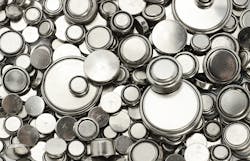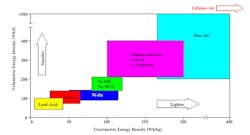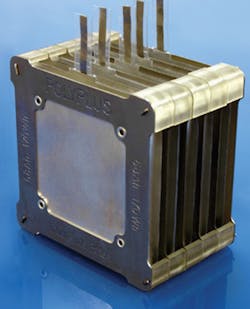Battery researchers agree that one of the most promising possibilities for future battery technology is the lithium-air (or lithium-oxygen) battery, which could provide three times as much power for a given weight than today’s leading technology, lithium-ion batteries. But tests of various approaches to creating such batteries have produced conflicting and confusing results, as well as controversies over how to explain them.
A comparison of a successful lithium-air battery in relation to other rechargeable batteries.
The promise of the lithium-air battery comes from the fact one of its two electrodes, which are usually made of metal or metal oxides, is replaced with air that flows in and out of the battery; a weightless substance is thus substituted for one of the heavy components. The other electrode in such batteries would be pure metallic lithium, a lightweight element.
Air-activated batteries have been used for years; for example, the zinc-air battery that is used in hearing aids and cameras. These current batteries are non-rechargeable types, but a rechargeable zinc-air battery has been proposed that is undergoing tests to determine its viability. The rechargeable zinc-air version uses a family of high-performance and low-cost catalysts to provide rechargeable capability.
The feasibility of lithium-air batteries is now being investigated by a team at MIT. They carried out detailed tests that seem to resolve the questions surrounding one promising material for such batteries: a compound called lithium iodide (LiI). The compound was seen as a possible solution to some of the lithium-air battery’s problems, including an inability to sustain many charging-discharging cycles, but conflicting findings had raised questions about the material’s usefulness for this task. The new study explains these discrepancies, and although it suggests that the material might not be suitable after all, the work provides guidance for efforts to overcome LiI’s drawbacks or find alternative materials.
The new results appear in the journal Energy and Environmental Science, in a paper by Yang Shao-Horn, MIT’s W.M. Keck Professor of Energy; Paula Hammond, the David H. Koch Professor in Engineering and head of the Department of Chemical Engineering; Michal Tulodziecki, a recent MIT postdoc at the Research Laboratory of Electronics; Graham Leverick, an MIT graduate student; Yu Katayama, a visiting student; and three others.
The theoretical promise of lithium-air batteries has been limited in practice because of three issues:
- Need for high voltages for charging;
- Low efficiency with regard to getting back the amount of energy put in; and
- Low cycle lifetimes, which result from instability in the battery’s oxygen electrode
Researchers have proposed adding lithium iodide in the electrolyte as a way of addressing these problems. But published results have been contradictory, with some studies finding the LiI does improve the cycling life, “while others show that the presence of LiI leads to irreversible reactions and poor battery cycling,” Shao-Horn says.
Previously, “most of the research was focused on organics” to make lithium-air batteries feasible, says Michal Tulodziecki, the paper’s lead author. But most of these organic compounds are not stable, he says, “and that’s why there’s been a great focus on lithium iodide [an inorganic material], which some papers said helps the batteries achieve thousands of cycles. But others say no, it will damage the battery.” In this new study, Tulodziecki says, “we explored in detail how lithium iodide affects the process, with and without water,” a comparison which turned out to be significant.
The team looked at the role of LiI on lithium-air battery discharge, using a different approach from most other studies. One set of studies was conducted with the components outside of the battery, which allowed the researchers to zero in on one part of the reaction, while the other study was done in the battery, to help explain the overall process.
They then used ultraviolet and visible-light spectroscopy and other techniques to study the reactions that took place. Both of these processes foster the production of different lithium compound such as LiOH (lithium hydroxide) in the presence of both LiI and water, instead of Li2O2 (lithium peroxide). LiI can enhance water’s reactivity and make it lose protons more easily, which promotes the formation of LiOH in these batteries and interferes with the charging process. These observations show that finding ways to suppress these reactions could make compounds such as LiI work better.
This study could point the way toward selecting a different compound instead of LiI to perform its intended function of suppressing unwanted chemical reactions at the electrode surface, Leverick says, adding that this work demonstrates the importance of “looking at the detailed mechanism carefully.”
Shao-Horn says that the new findings “help get to the bottom of this existing controversy on the role of LiI on discharge. We believe this clarifies and brings together all these different points of view.”
But this work is just one step in a long process of trying to make lithium-air technology practical, the researchers say. “There’s so much to understand,” says Leverick, “so there’s not one paper that’s going to solve it. But we will make consistent progress.”
“Lithium-oxygen batteries that run on oxygen and lithium ions are of great interest because they could enable electric vehicles of much greater range. However, one of the problems is that they are not very efficient yet,” says Larry Curtiss, a distinguished fellow at Argonne National Laboratory, who was not involved in this work. In this study, he says, “it is shown how adding a simple salt, lithium iodide, can potentially be used to make these batteries run much more efficiently. They have provided new insight into how the lithium iodide acts to help break up the solid discharge product, which will help to enable the development of these advanced battery systems.”
Curtiss adds that “there are still significant barriers remaining to be overcome before these batteries become a reality, such as getting long enough cycle life, but this is an important contribution to the field.”
The team also included recent MIT graduates Chibueze Amanchukwu PhD ’17 and David Kwabi PhD ’16, and Fanny Bardé of Toyota Motor Europe. The work was supported by Toyota Motor Europe and the Skoltech Center for Electrochemical Energy Storage, and used facilities supported by the National Science Foundation.
ARPA-E Programs
Primary focus of ARPA-E’s BEEST program (Batteries for Electrical Energy Storage in Transportation) is development of advanced battery chemistries, architectures, and manufacturing processes with the potential to provide EV battery-system level energy densities exceeding 200 Wh/kg (mass density) and 300 Wh/liter (volumetric density) at system-level costs of $250/kWh or below. It is ARPA-E’s belief that the required ambitious energy density and cost metrics for widespread adoption of EVs represent the most significant challenges and emerging technology opportunities facing battery technology development for EV applications today.
All metal-air battery chemistries are an area of interest. ARPA-E believes that particularly strong opportunities exist to borrow innovations from the fuel-cell field to improve the battery’s bifunctional air cathode.
One of ARPA-E’s projects is with the PolyPlus Battery Company (Berkeley, Calif.) that is developing ultra-high specific energy rechargeable lithium-air batteries based on protected lithium metal electrodes. They would be the world’s first commercially available rechargeable lithium-air (Li-Air) battery. Li-air batteries are better than the Li-ion batteries used in most EVs today because they breathe in air from the atmosphere for use as an active material in the battery, which greatly decreases its weight. Li-air batteries also store nearly 700% as much energy as traditional Li-ion batteries. A lighter battery would improve the range of EVs dramatically. PolyPlus is on track to making a critical breakthrough: the first manufacturable protective membrane between its lithium-based negative electrode and the reaction chamber where it reacts with oxygen from the air. This gives the battery the unique ability to recharge by moving lithium in and out of the battery’s reaction chamber for storage until the battery needs to discharge once again. Until now, engineers had been unable to create the complex packaging and air-breathing components required to turn Li-air batteries into rechargeable systems.
If successful, PolyPlus’ project would enable EVs to travel 500 miles on a single charge, much further than today’s EVs or gasoline-powered cars can go. An EV that is cost-competitive with gasoline would require a battery with twice the energy storage of today’s state-of-the-art Li-ion battery at 30% of the cost. If you increase the energy density, you can either extend the range or reduce the number of batteries needed. This battery would enable an EV to travel from New York City to Raleigh, N.C. (500 miles) on a single charge, for less than $10 on average.
PolyPlus is developing rechargeable and non-rechargeable Li-air, and Li-seawater batteries based on a Protected Li Electrode (PLE). At a nominal potential of about 3 V, the theoretical specific energy for a lithium-air battery is over 5,000 Wh/kg for the reaction forming LiOH and 11,000 Wh/kg for the reaction forming Li2O2 or for the reaction of lithium with dissolved oxygen in seawater, rivaling the energy density for hydrocarbon fuel cells and far exceeding Li-ion battery chemistry that has a theoretical specific energy of about 400 Wh/kg. PolyPlus intends to first commercialize non-rechargeable Li-air and Li-seawater batteries followed by the introduction of rechargeable Li-air. The projected energy density and specific energy for commercial Li-air batteries is on the order of 1000 Wh/l and 1000 Wh/kg. Li-seawater batteries, which use the ocean as the positive electrode, are even more energy-dense and should be introduced commercially at about 1500 Wh/l and 1500 Wh/kg. Li-air and Li-seawater batteries are based on non-toxic materials and are environmentally benign.
The PolyPlus Seawater Battery
CEO Dr. Steven J. Visco believes its PolyPlus batteries will reach the EV market in as many as 10 years. PolyPlus has calculated the theoretical energy density of its potential Li-air technology at 11,000 Wh/kg. “That’s a big, big number,” Visco says. “It’s more than an order of magnitude. Now, can you get it? It’s one thing to calculate—it’s another thing to actually do it.”
The company uses a solid electrolyte membrane to prevent direct electron transfer from the negative electrode to species in the aqueous electrolyte, therefore extending the voltage window from the oxidative limit of the aqueous electrolyte to the lithium electrode potential (~ 4.5 V). This technology allows the construction of practical aqueous lithium batteries with cell voltages similar to those of conventional Li-ion or lithium primary batteries, but with much higher energy density (for H2O or O2 cathodes). They have observed that the PLE is remarkably stable to aqueous electrolytes and does not appear to be susceptible to parasitic side reactions that can lead to self-discharge in batteries.
Also involved in research on Li-air batteries is the Missouri University of Science and Technology (Missouri S&T) in Rolla, Mo. The university was awarded an ARPA-E grant to improve cathode performance in lithium-air batteries.
Dr. Yangchuan Xing, associate professor of chemical and biological engineering at Missouri S&T, is leading the research at S&T. According to Xing, the three-year project will seek to dramatically improve lithium-air cathode performance through the development of a new electrode structure.
Assuming a successful lithium-air research project, there are still some questions:
- What is the energy density, specific energy, and weight?
- What is the effect of temperature change on these rechargeable batteries?
- How many times can these batteries be charged and recharged and still maintain the expected output voltage?
- What is the output voltage of a cell?
- How does humidity affect performance of the rechargeable battery?
- Are there electronic system packaging problems because these rechargeable batteries require access to air?
About the Author

Sam Davis
Sam Davis was the editor-in-chief of Power Electronics Technology magazine and website that is now part of Electronic Design. He has 18 years experience in electronic engineering design and management, six years in public relations and 25 years as a trade press editor. He holds a BSEE from Case-Western Reserve University, and did graduate work at the same school and UCLA. Sam was the editor for PCIM, the predecessor to Power Electronics Technology, from 1984 to 2004. His engineering experience includes circuit and system design for Litton Systems, Bunker-Ramo, Rocketdyne, and Clevite Corporation.. Design tasks included analog circuits, display systems, power supplies, underwater ordnance systems, and test systems. He also served as a program manager for a Litton Systems Navy program.
Sam is the author of Computer Data Displays, a book published by Prentice-Hall in the U.S. and Japan in 1969. He is also a recipient of the Jesse Neal Award for trade press editorial excellence, and has one patent for naval ship construction that simplifies electronic system integration.
You can also check out his Power Electronics blog.


